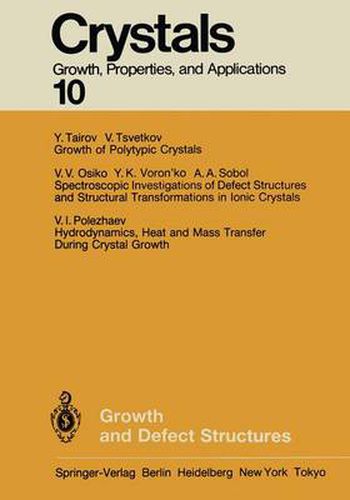Readings Newsletter
Become a Readings Member to make your shopping experience even easier.
Sign in or sign up for free!
You’re not far away from qualifying for FREE standard shipping within Australia
You’ve qualified for FREE standard shipping within Australia
The cart is loading…






This title is printed to order. This book may have been self-published. If so, we cannot guarantee the quality of the content. In the main most books will have gone through the editing process however some may not. We therefore suggest that you be aware of this before ordering this book. If in doubt check either the author or publisher’s details as we are unable to accept any returns unless they are faulty. Please contact us if you have any questions.
Polytypic crystals of semiconductors, dielectrics and magnetic materials attract an increasing attention in science and technology. On one hand, the phenomenon of polyty pism is one of the fundamental problems of solid-state physics; its solution would make it possible to elucidate- the problem of the interconnection of different structures and intraatomic forces acting in crystals. On the other hand, the polytypic difference in crystals is most strongly expressed in electro-physical properties, which makes their application promising, mainly in semiconductor electronics. Thus, the difficulties of pro ducing modulated structures in polytypic crystals can be overcome since these crystals form a class of one-dimensional natural superlattices. At present it has become clear that polytypism in crystals and compounds is the rule rather than an exception and it is determined by the conditions of their synthesis. This phenomenon seems to be rather widespread in nature and fundamental for crystal forma tion. H polytypism was recently thought to be but a specific structural feature of a few substances such as SiC, ZnS, CdI , etc. , by now this phenomenon has been discovered in 2 v an increasing range of crystalline substances, for example, in silicon, diamond, AIIIB , VI AIIB , AIBVII compounds, in ternary semiconducting compounds, metals, silicates, perovskites, mica, organic crystals. The more accurately the structural studies are per formed, the greater is the number of crystals of various substances found to exhibit the phenomenon of polytypism. Recently, excellent surveys have systematized our knowledge of polytypism.
$9.00 standard shipping within Australia
FREE standard shipping within Australia for orders over $100.00
Express & International shipping calculated at checkout
This title is printed to order. This book may have been self-published. If so, we cannot guarantee the quality of the content. In the main most books will have gone through the editing process however some may not. We therefore suggest that you be aware of this before ordering this book. If in doubt check either the author or publisher’s details as we are unable to accept any returns unless they are faulty. Please contact us if you have any questions.
Polytypic crystals of semiconductors, dielectrics and magnetic materials attract an increasing attention in science and technology. On one hand, the phenomenon of polyty pism is one of the fundamental problems of solid-state physics; its solution would make it possible to elucidate- the problem of the interconnection of different structures and intraatomic forces acting in crystals. On the other hand, the polytypic difference in crystals is most strongly expressed in electro-physical properties, which makes their application promising, mainly in semiconductor electronics. Thus, the difficulties of pro ducing modulated structures in polytypic crystals can be overcome since these crystals form a class of one-dimensional natural superlattices. At present it has become clear that polytypism in crystals and compounds is the rule rather than an exception and it is determined by the conditions of their synthesis. This phenomenon seems to be rather widespread in nature and fundamental for crystal forma tion. H polytypism was recently thought to be but a specific structural feature of a few substances such as SiC, ZnS, CdI , etc. , by now this phenomenon has been discovered in 2 v an increasing range of crystalline substances, for example, in silicon, diamond, AIIIB , VI AIIB , AIBVII compounds, in ternary semiconducting compounds, metals, silicates, perovskites, mica, organic crystals. The more accurately the structural studies are per formed, the greater is the number of crystals of various substances found to exhibit the phenomenon of polytypism. Recently, excellent surveys have systematized our knowledge of polytypism.